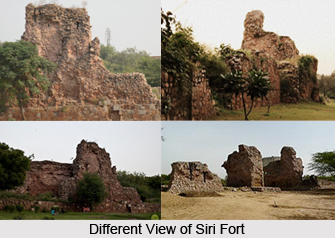 Siri Fort is located in the city of New Delhi. It was constructed during the reign of Ala-ud-Din Khilji of the Delhi Sultanate. The Fort was built 5 km to the north-east of the Qutab Minar on an old camp near Delhi. The fort was built to protect the city from attacks of the Mongols. It belongs to the second city of the medieval Delhi built around 1303. It is presently in ruins. Ala-ud-din is most famous person of the Khiliji Dynasty who built the city of Siri between 1297 and 1307. He was the second ruler of the Khiliji Dynasty. The fort also served as the seat of administration of his powers. Siri was then also known as "Darul Khilafat" or "Seat of Califate" Presently Siri is a part of New Delhi. Earlier it was associated with the fortifications of Jahanpanah.
Siri Fort is located in the city of New Delhi. It was constructed during the reign of Ala-ud-Din Khilji of the Delhi Sultanate. The Fort was built 5 km to the north-east of the Qutab Minar on an old camp near Delhi. The fort was built to protect the city from attacks of the Mongols. It belongs to the second city of the medieval Delhi built around 1303. It is presently in ruins. Ala-ud-din is most famous person of the Khiliji Dynasty who built the city of Siri between 1297 and 1307. He was the second ruler of the Khiliji Dynasty. The fort also served as the seat of administration of his powers. Siri was then also known as "Darul Khilafat" or "Seat of Califate" Presently Siri is a part of New Delhi. Earlier it was associated with the fortifications of Jahanpanah.
Legend of Siri Fort
According to the legend the fort has been named as Siri Fort as it has been built on the severed heads of about 8,000 Mongol soldiers killed in the war. In Hindi the word Siri means head. As per another legend when Ala-ud-din won a battle against the Mongols the soldiers arrested and brought to Siri. They were then trampled by elephants and their severed heads were hung on the walls of the Siri Fort.
Structure of Siri Fort
Siri Fort is the first city that had been built by the Muslims. It has been erected close to the Shahpur jat village that is resided by the Jats of the Panwar Gotra. The building is oval in shape. The ruins of the fort can be seen in an area of about 1.7 km2. It is said that Ala-ud-din Khilji was a very creative man and had a keen interest towards art and architecture. He is believed to have employed almost 70,000 workers for the construction of this massive city. The city was built with an oval plan and was dotted with magnificent palaces and other structures. The city had seven gates for entry and exit. However, only the South eastern gate at present is in proper condition and can be seen. Rest all the other gates are in ruined state or demolished.
Siri Fort was earlier regarded as a standing glory of the city for its lavish palace that was supported by a thousand pillars called the Hazar Sutan. The palace had been constructed beyond the boundary of the fort. It was adorned with marble floors and the stone decorations of the palatial building added to its charm and beauty. The main door of the palace had been tastefully decorated and embellished with intricate architectural design. Flame shaped battlements can be located on the eastern part of the ruins. There were also loop holes for arrows and bastions which were regarded as a new and unique design of that era.
Apart from the Siri Fort there is also a citadel around it. The water supply system with a reservoir had been constructed at the Hauz Khas Complex. It was done for supplying water to Siri, the new city of Ala-ud-din. The emperor had also further expanded and developed the city for religious purposes. He also got constructed the Quwwatul Islam Mosque here. The Siri Fort was distrusted by the local rulers who took away the fort`s stones, bricks and other artefacts for constructing their own buildings. Sher Shah Suri of Pashtun Afghan descent also removed material from Siri to build his own city. The ruined walls of the fort had a wider base and had a protected passage built within the walls.
Siri Fort along with many other forts has the architectural design and pattern of the Khaliji Dynasty. Ala-ud-din Khilji was very passionate about building monuments and he employed the best artisans and craftsmen to build them.




